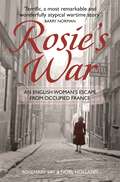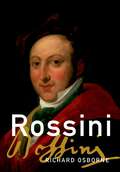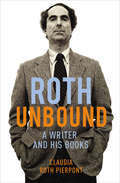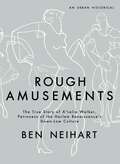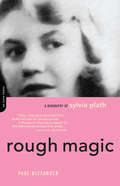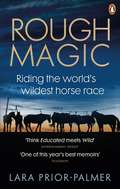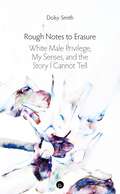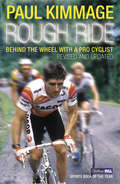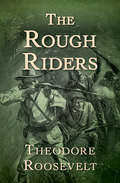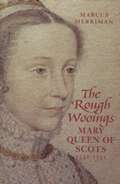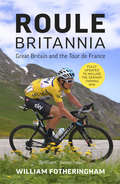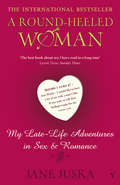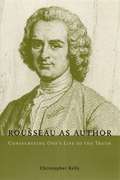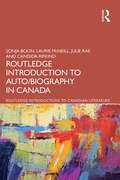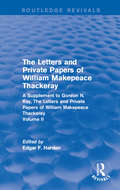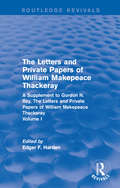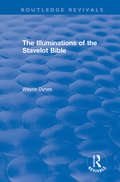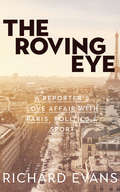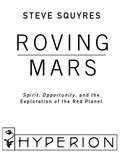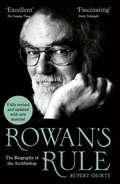- Table View
- List View
Rosie's War: An Englishwoman's Escape From Occupied France
by Noel Holland Rosemary SayRosie, a young Englishwoman from a comfortable middle-class background, left her London home in 1939 to work as an au pair in Avignon in the South of France. Even the outbreak of war later that year did little to disturb her happy life there, until 1940 when Hitler launched an all-out assault on Western Europe. Trying to escape back to Britain, Rosie was only able to flee as far as Paris, where she was eventually rounded up as an 'enemy alien' and sent to a German-run prison camp in Eastern France. Desperate to escape, she eventually did so with an equally industrious friend, Frida. After many months on the run in France, the young women finally reached the unoccupied city of Marseille. From there, they continued to flee through France, Spain and Portugal, at last arriving in Ireland where they were able to catch a plane back to Britain. Moving, enthralling, and inspirational, Rosie's War is a book for all to enjoy.
Rossini (Master Musicians Series)
by Richard OsborneGioachino Rossini was one of the most influential, as well as one of the most industrious and emotionally complex of the great nineteenth-century composers. Between 1810 and 1829, he wrote 39 operas, a body of work, comic and serious, which transformed Italian opera and radically altered the course of opera in France. His retirement from operatic composition in 1829, at the age of 37, was widely assumed to be the act of a talented but lazy man. In reality, political events and a series of debilitating illnesses were the determining factors. After drafting the Stabat Mater in 1832, Rossini wrote no music of consequence for the best part of twenty-five years, before the clouds lifted and he began composing again in Paris in the late 1850s. During this glorious Indian summer of his career, he wrote 150 songs and solo piano pieces his 'Sins of Old Age' and his final masterpiece, the Petite Messe solennelle. The image of Rossini as a gifted but feckless amateur-the witty, high-spirited bon vivant who dashed off The Barber of Seville in a mere thirteen days-persisted down the years, until the centenary of his death in 1968 inaugurated a process of re-evaluation by scholars, performers, and writers. The original 1985 edition of Richard Osborne's pioneering and widely acclaimed Rossini redefined the life and provided detailed analyses of the complete Rossini oeuvre. Twenty years on, all Rossini's operas have been staged and recorded, a Critical Edition of his works is well advanced, and a scholarly edition of his correspondence, including 250 previously unknown letters from Rossini to his parents, is in progress. Drawing on these past two decades of scholarship and performance, this new edition of Rossini provides the most detailed portrait we have yet had of one of the worlds best-loved and most enigmatic composers.
Rossini (Master Musicians Series)
by Richard OsborneGioachino Rossini was one of the most influential, as well as one of the most industrious and emotionally complex of the great nineteenth-century composers. Between 1810 and 1829, he wrote 39 operas, a body of work, comic and serious, which transformed Italian opera and radically altered the course of opera in France. His retirement from operatic composition in 1829, at the age of 37, was widely assumed to be the act of a talented but lazy man. In reality, political events and a series of debilitating illnesses were the determining factors. After drafting the Stabat Mater in 1832, Rossini wrote no music of consequence for the best part of twenty-five years, before the clouds lifted and he began composing again in Paris in the late 1850s. During this glorious Indian summer of his career, he wrote 150 songs and solo piano pieces his 'Sins of Old Age' and his final masterpiece, the Petite Messe solennelle. The image of Rossini as a gifted but feckless amateur-the witty, high-spirited bon vivant who dashed off The Barber of Seville in a mere thirteen days-persisted down the years, until the centenary of his death in 1968 inaugurated a process of re-evaluation by scholars, performers, and writers. The original 1985 edition of Richard Osborne's pioneering and widely acclaimed Rossini redefined the life and provided detailed analyses of the complete Rossini oeuvre. Twenty years on, all Rossini's operas have been staged and recorded, a Critical Edition of his works is well advanced, and a scholarly edition of his correspondence, including 250 previously unknown letters from Rossini to his parents, is in progress. Drawing on these past two decades of scholarship and performance, this new edition of Rossini provides the most detailed portrait we have yet had of one of the worlds best-loved and most enigmatic composers.
Roth Unbound: A Writer And His Books
by Claudia Roth PierpontPhilip Roth – one of the most renowned writers of his generation – hardly needs introduction. From his debut, Goodbye, Columbus, which won the National Book Award, to his Pulitzer Prize-winning American Pastoral, to his eternally inventive later works such as Exit Ghost and Nemesis, Roth has produced some of the greatest literature of the past hundred years. And yet there has been no major critical work about him, until now. Here, at last, is the story of Roth’s creative life. Claudia Roth Pierpont tells an engaging story even as she delves into the many complexities of Roth’s work and the controversies it has raised. This is not a biography – though it contains many biographical details – but something more rewarding: an attempt to understand a great writer through his art.Pierpont, who has known Roth for several years, peppers her gracefully written and carefully researched account with conversational details, providing insights and anecdotes previously accessible only to a very few, touching on Roth’s family, his inspirations, his critics, the full range of his fiction, and his literary friendships with such figures as Saul Bellow and John Updike.Roth Unbound is a major achievement, a fascinating and highly readable work that will set the standard for Roth scholarship for years to come.
Rough Amusements: The True Story of A'Lelia Walker, Patroness of the Harlem Renaissance's Down-Low Culture
by Ben NeihartWhen A'Lelia Walker died in 1931 after a midnight snack of lobster and chocolate cake washed down with champagne, it marked the end of one of the most striking social careers in New York's history. The daughter of rags-to-riches multi-millionaire Madame C.J. Walker (the washerwoman who marketed the most successful straightening technique for African American hair), A'Lelia was America's first black poor little rich girl, using her inheritance to throw elaborate, celebrity-packed parties in her Westchester Mansion and her 136th Street would-be salon, 'Dark Tower'. In Rough Amusements, third in Bloomsbury's Urban Historicals series, Neihart takes us into the heart of A'Lelia's world-gay Harlem in the 1920s. In tracing its cultural antecedents, he delves into the sexual subculture of nineteenth-century New York, exploring mixed-race prostitution; the bachelorization of New York society; French Balls ("the most sophisticated forum for testing the boundaries of urban sexual behavior"); and The Slide (New York's most depraved nineteenth-century bar). Using A'Lelia's lavish parties as a jumping-off point, Neihart traces the line connecting Davy Crockett's world without women to Walt Whitman's boundless love of beautiful men to A'Lelia's cultivation of the racial, social, and sexual risk that defined the Harlem Renaissance.
Rough Magic: A Biography Of Sylvia Path
by Paul AlexanderSince her suicide at age thirty, Sylvia Plath (1932-1963) has been celebrated for her impeccable and ruthless poetry. Rough Magic probes the events of Plath's life, including her turbulent marriage to the poet Ted Hughes.
Rough Magic: Riding the world’s wildest horse race
by Lara Prior-Palmer'[Prior-Palmer's] gorgeous, sensual depiction of this race is a literary marvel; it feels like you are riding alongside her across the desolate steppes; her verbal acuity makes vivid the most elusive of landscapes; her triumph becomes ours' NYLONThe Mongol Derby is the world’s toughest horse race. A feat of endurance across the vast Mongolian plains once traversed by the people of Genghis Khan, competitors ride 25 horses across a distance of 1000km. Many riders don’t make it to the finish line.In 2013 Lara Prior-Palmer – nineteen, underprepared but seeking the great unknown – decided to enter the race. Driven by her own restlessness, stubbornness, and a lifelong love of horses, she raced for seven days through extreme heat and terrifying storms, catching a few hours of sleep where she could at the homes of nomadic families. Battling bouts of illness and dehydration, exhaustion and bruising falls, she found she had nothing to lose, and tore through the field with her motley crew of horses. In one of the Derby’s most unexpected results, she became the youngest-ever champion and the first woman to win the race.A tale of adventure, fortitude and poetry, Rough Magic is the extraordinary story of one young woman’s encounter with oblivion, and herself.
Rough Notes to Erasure: White Male Privilege, My Senses, and the Story I Cannot Tell
by Dolsy SmithWe are living through the wrack of the White Male. As the compact between social hierarchy, inherited privilege, and race (reinforced by gender and other normative categories) shows signs of buckling, his rage and resentment threaten us all. For he is a thing possessed: possessed by his own love of possession, and born to a sense that the world belongs to him and him alone. The spoils of oppression lie coiled inside him, a glut he can’t digest, and murder beckons behind the respect that he conceives of as his due." A hybrid of critical essay and memoir, and Rough Notes to Erasure contributes to a growing body of work that wrestles with the tacit and embodied nature of privilege and prejudice, and it contributes not only via argument but also through style. Taking inspiration from feminist/queer poetics and what Fred Moten calls “the black avant-garde,” these rough notes address the remainder that gets lost in explicit argument, which is the flesh. Where privilege roils through history, and empire whets the appetites. But also where the world catches on its own fractalization by thought, feeling, and desire; and language recovers, for a moment or two, the power to entangle us with our mother tongue.
Rough Ride: Behind the Wheel with a Pro Cyclist (Yellow Jersey Cycling Classics Ser.)
by Paul KimmageAn eye-opening expose of and a heart-breaking lament for professional cyclingPaul Kimmage's boyhood dreams were of cycling glory: wearing the yellow jersey, cycling the Tour de France, becoming a national hero. He knew it wouldn't come easy, but he was prepared to put in the graft. The dedication paid off – he finished sixth in the World Championships as an amateur and in 1986, he turned professional.He soon discovered it wasn't about courage, training hours or how much you wanted to win. It was about gruelling defeats, total exhaustion, and drugs - drugs that would allow you to finish the race and start another day. Kimmage ultimately left the sport to write this book – profoundly honest and ground-breaking, Rough Ride broke the silence surrounding the issue of drugs in sport, and documents one man’s love for, and struggle with, the complex world of professional cycling. ‘A must read for any cyclist’ CyclistWINNER OF WILLIAM HILL SPORTS BOOK OF THE YEAR
The Rough Riders
by Theodore RooseveltTheodore Roosevelt’s bestselling memoir chronicling the 1st United States Volunteer Cavalry and its victory at San Juan Hill in the Spanish-American War. Yearning to join the fight for Cuban independence in the Spanish–American War, Theodore Roosevelt and Col. Leonard Wood formed the 1st United States Volunteer Cavalry. They enlisted a motley crew from all walks of life, from cowboys and frontiersmen to Ivy League graduates. These 1,250 men became known as the Rough Riders. After training in San Antonio, Texas, they set out for the tropical jungles of Cuba. As they grappled with hunger, malaria, and occasional defeat, their many battles with the Spanish Army culminated in the death-defying charge to victory at San Juan Hill. Through it all, Roosevelt kept a pocket diary in which he made daily entries about his experiences and the men who fought beside him. Imbued with his trademark vigor and certainty of purpose, Roosevelt’s firsthand account of this historic campaign paints a vivid picture of the rugged, independent spirit that came to define American heroism. This ebook has been professionally proofread to ensure accuracy and readability on all devices.
The Rough Wooings: Mary Queen of Scots 1542–1551
by Marcus MerrimanThe ‘Rough Wooings’, fought by major figures of sixteenth-century Europe for the hand of the young Mary Queen of Scots, were wars as intense, wide-ranging and devastating as the wars of the three Edwards which ravaged fourteenth-century Scotland.But the Wooings were wars of independence as well. As the kings of England and France vied to control the bestowing of Mary’s hand in marriage, so Scotland itself strove to remain free of them. And Scotland won, although it was a close-run thing. The politics and international diplomacy involved were as sophisticated and complex as the century provides; the warfare and political literature as revolutionary and modern as for any part of Europe. Protestant zealots were forged on its anvil; massive navies ranged the North Sea; Italian military technology was brought to bear. All for one of the most fascinating queens in history.This is the story of her beginning, a rich and vibrant epic involving many of the major figures of early modern history: Henry VIII of England, François I and Henri II of France bestride the canvas, but even they cannot obscure the beguiling figure of the young Mary Queen of Scots.
Roule Britannia: Great Britain and the Tour de France
by William FotheringhamHow did Great Britain conquer the Tour de France?In 2012 Bradley Wiggins made history by becoming the first Briton ever to win the Tour de France. His compatriot Chris Froome came second while fellow Brits, the 'fastest man on earth' Mark Cavendish and reformed doper David Millar, made sure that between them Britain accounted for 7 of a possible 21 stage wins. The golden era of British cycling had begun. In Roule Britannia, number one bestselling author William Fotheringham, charts British cycling's rise to the top and provides us with the definitive account of the nation’s Tour de France achievements through exclusive interviews with and profiles of cycling champions - from the early days of Brian Robinson to Bradley Wiggins's dominant ride via Tom Simpson, Robert Millar, Chris Boardman and many others, Roule Britannia celebrates a nation's love affair with the greatest race of all.‘Brilliant...tells each story with passion and sensitivity’ Sunday Times
A Round-Heeled Woman: My Late-life Adventures In Sex And Romance
by Jane Juska'Before I turn 67 - next March - I would like to have a lot of sex with a man I like. If you want to talk first, Trollope works for me.' - Small ad in the New York Review of BooksJane Juska placed her ad in the New York Times and the response was overwhelming. She took a sabbatical from teaching just to have time to respond and meet some of the men - the result is this engaging, funny and utterly frank account of her exploits. It's high time someone revealed the fact that older single people are as eager for sex and intimacy as their younger counterparts. Jane Juska's brave and honest memoir raises eyebrows and blood pressure in what is undoubtedly an inspiring account of one woman's daring adventures in sex and romance.
Rousseau as Author: Consecrating One's Life to the Truth
by Christopher KellyFor Rousseau, "consecrating one's life to the truth" (his personal credo) meant publicly taking responsibility for what one publishes and only publishing what would be of public benefit. Christopher Kelly argues that this commitment is central to understanding the relationship between Rousseau's writings and his political philosophy. Unlike many other writers of his day, Rousseau refused to publish anonymously, even though he risked persecution for his writings. But Rousseau felt that authors must be self-restrained, as well as bold, and must carefully consider the potential political effects of what they might publish: sometimes seeking the good conflicts with writing the truth. Kelly shows how this understanding of public authorship played a crucial role in Rousseau's conception—and practice—of citizenship and political action. Rousseau as Author will be a groundbreaking book not just for Rousseau scholars, but for anyone studying Enlightenment ideas about authorship and responsibility.
The Routledge Introduction to Auto/biography in Canada (Routledge Introductions to Canadian Literature)
by Sonja Boon Laurie McNeill Julie Rak Candida RifkindThe Routledge Introduction to Auto/biography in Canada explores the exciting world of nonfiction writing about the self, designed to give teachers and students the tools they need to study both canonical and lesser-known works. The volume introduces important texts and contexts for interpreting life narratives, demonstrates the conceptual tools necessary to understand what life narratives are and how they work, and offers an historical overview of key moments in Canadian auto/biography. Not sure what life writing in Canada is, or how to study it? This critical introduction covers the tools and approaches you require in order to undertake your own interpretation of life writing texts. You will encounter nonfictional writing about individual lives and experiences—including biography, autobiography, letters, diaries, comics, poetry, plays, and memoirs. The volume includes case studies to provide examples of how to study and research life narratives and toolkits to help you apply what you learn. The Routledge Introduction to Auto/biography in Canada provides instructors and students with the contexts and the critical tools to discover the power of life writing, and the skills to study any kind of nonfiction, from Canada and around the world.
The Routledge Introduction to Auto/biography in Canada (Routledge Introductions to Canadian Literature)
by Sonja Boon Laurie McNeill Julie Rak Candida RifkindThe Routledge Introduction to Auto/biography in Canada explores the exciting world of nonfiction writing about the self, designed to give teachers and students the tools they need to study both canonical and lesser-known works. The volume introduces important texts and contexts for interpreting life narratives, demonstrates the conceptual tools necessary to understand what life narratives are and how they work, and offers an historical overview of key moments in Canadian auto/biography. Not sure what life writing in Canada is, or how to study it? This critical introduction covers the tools and approaches you require in order to undertake your own interpretation of life writing texts. You will encounter nonfictional writing about individual lives and experiences—including biography, autobiography, letters, diaries, comics, poetry, plays, and memoirs. The volume includes case studies to provide examples of how to study and research life narratives and toolkits to help you apply what you learn. The Routledge Introduction to Auto/biography in Canada provides instructors and students with the contexts and the critical tools to discover the power of life writing, and the skills to study any kind of nonfiction, from Canada and around the world.
Routledge Revivals (1994): A Supplement to Gordon N. Ray, The Letters and Private Papers of William Makepeace Thackeray
by Edgar F. HardenFirst published in 1994, these two volumes are intended as a supplement to the four-volume edition edited by Gordon N. Ray in 1945-46. In writing to his broad range of correspondents, Thackeray produced a varied body of letters that will help readers to better understand his nineteenth-century society as well as his professional and private life — especially his relationships with women. These volumes contain 1713 letters: 1464 to and from Thackeray that were not included in the earlier volumes, and 249 with texts that have been edited from newly available manuscripts, and that thereby replace texts that were printed in Ray from incomplete sources.
Routledge Revivals (1994): A Supplement to Gordon N. Ray, The Letters and Private Papers of William Makepeace Thackeray
by Edgar F. HardenFirst published in 1994, these two volumes are intended as a supplement to the four-volume edition edited by Gordon N. Ray in 1945-46. In writing to his broad range of correspondents, Thackeray produced a varied body of letters that will help readers to better understand his nineteenth-century society as well as his professional and private life — especially his relationships with women. These volumes contain 1713 letters: 1464 to and from Thackeray that were not included in the earlier volumes, and 249 with texts that have been edited from newly available manuscripts, and that thereby replace texts that were printed in Ray from incomplete sources.
Routledge Revivals (1994): A Supplement to Gordon N. Ray, The Letters and Private Papers of William Makepeace Thackeray
by Edgar F. HardenFirst published in 1994, these two volumes are intended as a supplement to the four-volume edition edited by Gordon N. Ray in 1945-46. In writing to his broad range of correspondents, Thackeray produced a varied body of letters that will help readers to better understand his nineteenth-century society as well as his professional and private life — especially his relationships with women. These volumes contain 1713 letters: 1464 to and from Thackeray that were not included in the earlier volumes, and 249 with texts that have been edited from newly available manuscripts, and that thereby replace texts that were printed in Ray from incomplete sources.
Routledge Revivals (1994): A Supplement to Gordon N. Ray, The Letters and Private Papers of William Makepeace Thackeray
by Edgar F. HardenFirst published in 1994, these two volumes are intended as a supplement to the four-volume edition edited by Gordon N. Ray in 1945-46. In writing to his broad range of correspondents, Thackeray produced a varied body of letters that will help readers to better understand his nineteenth-century society as well as his professional and private life — especially his relationships with women. These volumes contain 1713 letters: 1464 to and from Thackeray that were not included in the earlier volumes, and 249 with texts that have been edited from newly available manuscripts, and that thereby replace texts that were printed in Ray from incomplete sources.
Routledge Revivals: The Illuminations of the Stavelot Bible (Routledge Revivals)
by Wayne DynesFirst published in 1978, this book offers a comprehensive study of the illuminations of the Stavelot Bible. The illuminations themselves have been recognized as occupying an important place in the incipient stage of the Romanesque style in the Meuse valley. The two volumes of the Bible contain no less than ninety-seven illuminated initials, almost half of them containing figures. Wayne Dynes’s study brings this into context by giving the historical background of the abbey of Stavelot and the manuscript itself, and then the exegetical and illustrative tradition shaping earlier illuminated Bibles. A third chapter examines the question of the assignment of the hands, providing at the same time a survey of the contents. This clears the way for discussions of areas of importance including the famous full-page composition of Christ in Majesty, and analyses key miniatures and groups of miniatures. This procedure serves to clarify the overall scheme of illumination and permit a comparison with earlier achievements in the history of Bible illumination.
Routledge Revivals: The Illuminations of the Stavelot Bible (Routledge Revivals)
by Wayne DynesFirst published in 1978, this book offers a comprehensive study of the illuminations of the Stavelot Bible. The illuminations themselves have been recognized as occupying an important place in the incipient stage of the Romanesque style in the Meuse valley. The two volumes of the Bible contain no less than ninety-seven illuminated initials, almost half of them containing figures. Wayne Dynes’s study brings this into context by giving the historical background of the abbey of Stavelot and the manuscript itself, and then the exegetical and illustrative tradition shaping earlier illuminated Bibles. A third chapter examines the question of the assignment of the hands, providing at the same time a survey of the contents. This clears the way for discussions of areas of importance including the famous full-page composition of Christ in Majesty, and analyses key miniatures and groups of miniatures. This procedure serves to clarify the overall scheme of illumination and permit a comparison with earlier achievements in the history of Bible illumination.
The Roving Eye: A Reporter's Love Affair With Paris, Politics & Sport
by Richard EvansGo. Be there. For the past six decades Richard Evans has followed that dictum - being where the action was, not just as a tennis writer and broadcaster - 196 Grand Slams and counting - but through his years as a foreign correspondent in America, France and Vietnam as well as a spell as a roving global reporter for the US television programme Entertainment Tonight.Evans, whose English family fled France in June 1940, also became a National Service Captain in the British army, without having to dodge a bullet which was not the case in Cambodia nor in Miami where he was struck by a cop during an anti-Nixon demonstration.Evans was in Memphis hours after Martin Luther King was shot; campaigned through Indiana and California with Bobby Kennedy - "a unique politician" - before he, too, was assassinated and witnessed the pre-Olympic demonstrations in 1968 against the Mexican Government which ended in massacre.He accompanied the Wimbledon champion and activist Arthur Ashe on two trips to Africa, witnessing the dark days of apartheid and was back in South Africa in 1990 covering Mike Gatting's rebel cricket tour during the historic weeks that saw Nelson Mandela released and apartheid abolished.Evans paints an insider's portrait of Margaret Thatcher and No 10 Downing Street during the time he was with the Prime Minister's daughter, Carol; a romance with the actress Gayle Hunnicutt and two marriages; friendships with Richard Harris, Michael Crawford and more Wimbledon champions than you could fit into the players' box. He was also the last person to interview Richard Burton.A life lived to the full, covering the globe with a Roving Eye - being there.
Roving Mars: Spirit, Opportunity, and the Exploration of the Red Planet
by Steven SquyresSteve Squyres is the face and voice of NASA's Mars Exploration Rover mission. Squyres dreamed up the mission in 1987, saw it through from conception in 1995 to a successful landing in 2004, and serves as the principal scientist of its $400 million payload. He has gained a rare inside look at what it took for rovers Spirit and Opportunity to land on the red planet in January 2004--and knows firsthand their findings.
Rowan's Rule: The Biography Of The Archbishop Of Canterbury
by Rupert ShorttThis major new edition of Rupert Shortt's acclaimed biography of Rowan Williams provides fresh insight into the life and thought of perhaps the most gifted Christian leader of our time. Unburdened by national office, the former Archbishop has spoken more candidly than ever about the multiple conflicts - over gay clergy, women bishops and the place of faith in the public square - that rocked the Anglican Church and wider society during his decade at the helm.
